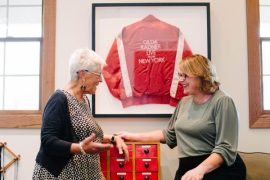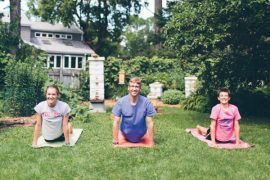RICHARD DAVIDSON’S KINDNESS CURRICULUM FOR KIDS
WITH THE LIGHTS DIM and their voices quiet, the 4K students in the Rainbow Room at the Waisman Early Childhood Program sit ready on their carpet squares in a circle. But this circle time isn’t for a giggiy game-Teacher Lisa Hawkins asks the students to close their eyes and listen for the bell— the meditation bell—to stop ringing as their cue to open their eyes.
Next, the children decide as a group to do three “balloon breaths,” placing their little hands atop their heads and lifting them to a balloon shape as they breathe in, then putting them back down on their heads as they breathe out. Hawkins reminds the children that each can do more if they’d like to, and a little girl in a green-and-white-stripe dress decides to do one more, announcing it to the class.
The class moves on to “belly buddies,” each of the children choosing a small rock to place on their bellies while they lie down, another opportunity to really focus on their breathing, feeling the rock move as they breathe in and out.
After a few minutes, the children sit up again and Hawkins asks them how their body is feeling. Many reply “calm” or “better.” “Good! Really good,” the little girl who did the extra balloon breath responds animatedly.
Finally, the class reviews their “Be kind and be careful” rule, a mantra of daily classroom life in the Rainbow Room. Hawkins, who tries to incorporate this routine almost every day after their large active time outside or in the gym, says she sees a noticeable difference in the children’s overall demeanor, especially those who have a harder time transitioning from one activity to the next.
The routine practiced by the Rainbow Room kids is all part of the Kindness Curriculum, developed in the same building as the early childhood program by the Center for Investigating Healthy Minds and piloted by experts at the Waisman Early Childhood Program.
The person behind the both the center and the curriculum is Richard Davidson, world-renowned for his research on how the brain really works and how compassion and meditation training can actually rewire your brain for the better.
After years of wowing the world including the Dalai Lama, and Time Magazine, who named him among the Top 100 influential people in the world in 2006—with his positive results among adults, Davidson is now focusing on children right here in our neighborhoods.
Davidson came to the UW-Madison in 1984, after earning his Ph.D. from Harvard University. He is a professor of psychology and psychiatry and director of the Waisman Laboratory for Brain Imaging and Behavior and the Laboratory for Affective Neuroscience. Brain research and the knowledge of the inner workings of the brain has come a long way since the ’70s, when Davidson was a graduate student and just delving into this world.
“There wasn’t even a concept of neuroplasticity— maybe just a vague intuition about it. We were taught we were all born with a fixed complement of brain cells,” says Davidson. “We all know now that’s just wrong. New cells are growing every day. [It’s a] much more dynamic system than any of us had any inkling about back then.”
Much of the current research about the mind and all its inner workings has been compiled in Madison by Davidson and his team. In 2008, he founded the Center for Investigating Healthy Minds, which is focused on understanding the nature of suffering and wellbeing and how wellbeing can be cultivated through a scientific understanding of the mind.
One of the most essential findings to come out of the research is that well being is a learned skill. “We are using hardnosed science to investigate the ways in which well being can be learned and the causes and consequences of that,” says Davidson.
And it’s precisely that “hard-nosed science” which Davidson knows is crucial for the powers that be to take any of this seriously and see it as a worthy investment.
“They’re hungry for these ideas and that would just be unimaginable if there wasn’t the science to back it up,” says Davidson.
Introducing a concept such as the Kindness Curriculum, a 12-week program for preschoolers that incorporates elements of mindfulness in age-appropriate ways so they can learn to better focus their minds and attention, would be unimaginable in a public school setting if there weren’t scientific evidence backingup its positive effects.
According to Davidson, between the ages of 5 and 7 the brain undergoes a massive reorganization. “If we can catch [children] during this time, the bang for the buck is so much greater,” says Davidson. “Once a child learns to quiet their mind in this way…they recognize that it’s helpful and they want more of it, [it’s] tremendously gratifying.”
Not to say teaching kindness and meditation to anyone older than 7 is a lost cause, stresses Davidson. “Plasticity occurs throughout life. It never stops,” he says. “But there are periods of increased plasticity.”
But he believes there is already a lot of attention being given to the practice in adulthood and would like to see the focus shift toward children. In fact, several of the Madison Municipal School District’s elementary schools have incorporated a form of the Kindness Curriculum into their programs.
“There are some schools we’ve worked in where the whole culture has changed,” says Davidson.
One such school is Lincoln Elementary in Madison, where Principal Deborah Hoffman believes including mindfulness in the 4th- and 5th-grade curriculums over the past five years has been a contributing factor to their high attendance and low behavior intervention rates. “For schools like ours that have similar challenges and needs, I think we’re doing better at positive behaviors and discipline than other schools in MMSD and the state,” says Hoffman.
There is also a trickle-down effect from the teachers participating in these mindfulness practices regularly. “If the stress level of a teacher is super high the students are going to be different,” says Hoffman.
The teachers at Lincoln participated in a research project that tested their cortisol— or stress hormone—levels at the beginning and end of the school day. Before incorporating mindfulness into their curriculum, there was a significant increase in teachers’ Cortisol levels by the end of the day. However, after the mindfulness program was a regular part of the routine, Cortisol levels showed no increase at the end of the day.
Hoffman says the program helps kids focus and tune out stimuli around them, while tuning in to their own needs and being more self-aware.
“Our goal is to have students be able to control their bodies in line with their emotions… [and] be available for learning,” says Hoffman, “That’s our motivation for doing these practices—to increase happiness and well being to increase their openness to learning.”
There are also plans in the works to pilot a parent program with families at the Dane County Head Start schools, as well as intensive parent training at Waisman Early Childhood Program. Up until this point, the program has primarily focused on the children and teachers in the school setting. Teachers go through a 10-week introduction to mindfulness practices and the Kindness Curriculum before these concepts are introduced into the classroom. Having these lessons now carry through between home and school will continue to create an even greater positive impact in these children’s lives.
The center has also done studies in MMSD classrooms evaluating the curriculum’s impact on a variety of different outcome measures including attention, sharing, delay of gratification and grades, all of which show demonstrable, measurable positive changes, according to Davidson.
“The data are quite strong and definitely underscore the promise of this curriculum,” says Davidson, who expects the research findings to be published in the near future.
“[Teaching children mindfulness] is not just something that we have as a moral obligation as a culture, but this is going to save taxpayers money,” says Davidson. “It’s pennywise and pound foolish not to invest in this.”
Plus, common sense tells us that this curriculum and similar interventions can have an enormous impact at relatively low costs. No special equipment necessary just your own mind.
“Everyone has this within them,” says Davidson. “We’re really trying to nurture seeds that we think are there from the start.”
And in our world where it seems like the pace gets faster every day, it’s not just children that will benefit from programs like the Kindness Curriculum. “Most people would agree that we can use a little bit more kindness and a little bit more focus in our daily lives. I’m 100 percent convinced that we can do better,” says Davidson.
Teaching children and adults, alike, to be more mindful and think more kindly isn’t necessarily going to create world peace, but it’s a step in the right direction. And it doesn’t have to be a big to-do; just a part of our daily routine. That’s what Davidson hopes for, anyway.
“I envision a day when mental exercise will be as much a part of our daily lives as physical exercise and personal hygiene,” he concludes. “We take care of our teeth each day. We should also take care of our mind.”
– Candice Wagener



